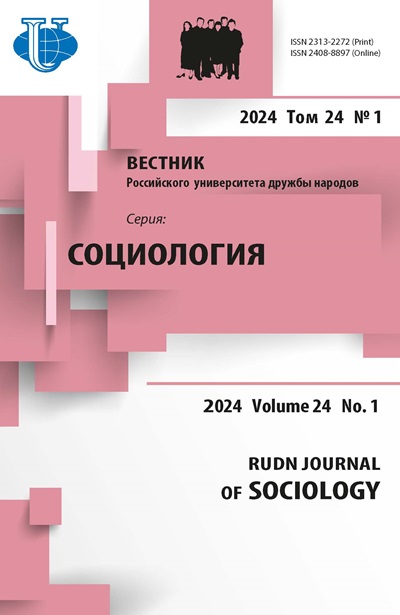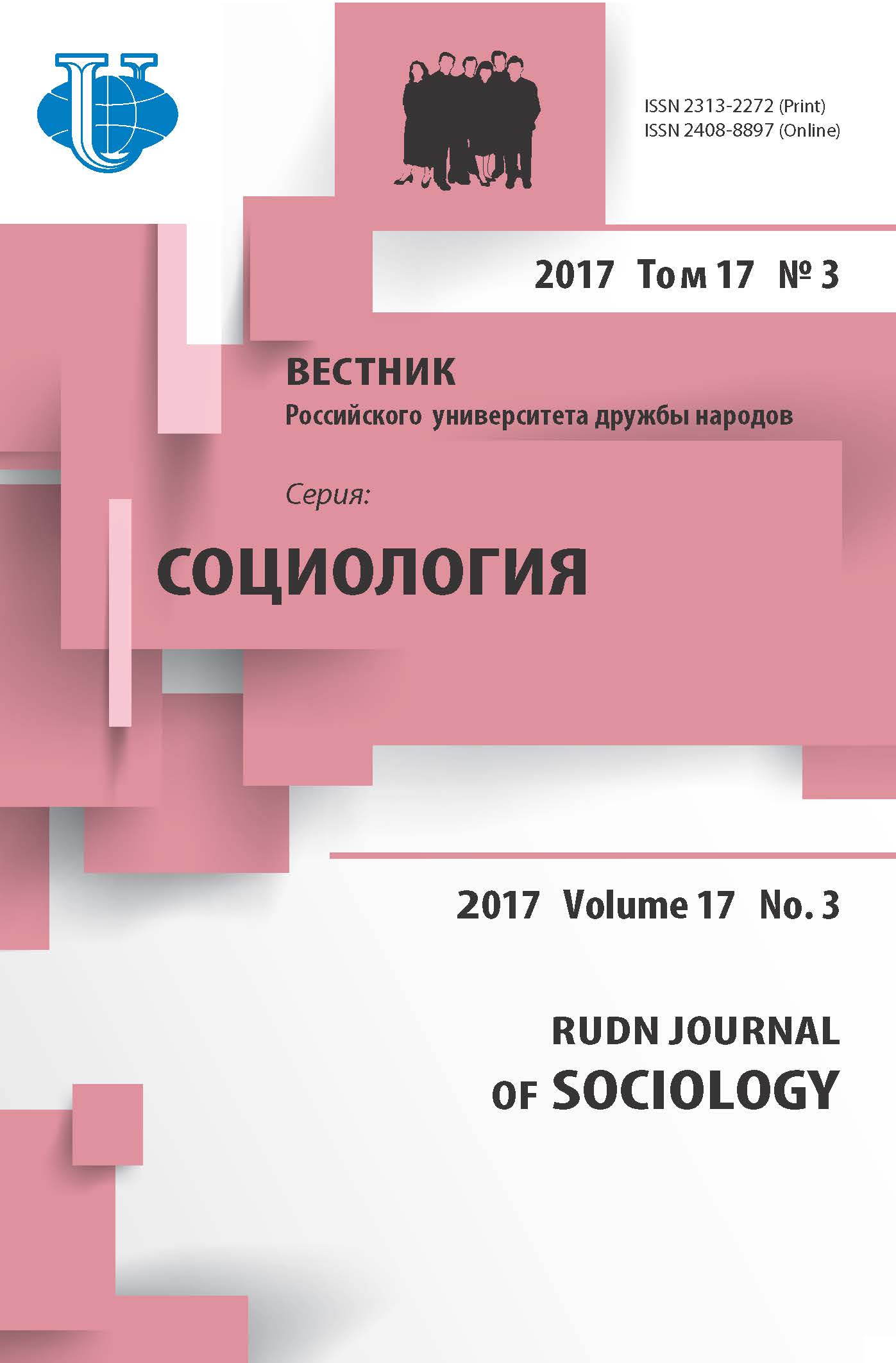THE STUDY OF SOCIAL REPRESENTATIONS BY THE VIGNETTE METHOD: A QUANTITATIVE INTERPRETATION
- Authors: Puzanova Z.V1, Tertyshnikova AG1
-
Affiliations:
- RUDN University (Peoples’ Friendship University of Russia)
- Issue: Vol 17, No 3 (2017)
- Pages: 306-316
- Section: Theory, Methodology and History of Sociological Research
- URL: https://journals.rudn.ru/sociology/article/view/16803
- DOI: https://doi.org/10.22363/2313-2272-2017-17-3-306-316
Cite item
Full Text
Abstract
The article focuses on the prospects of creating vignettes as a new method in empirical sociology. It is a good alternative to the conventional mass survey methods. The article consists of a few sections differing by the focus. The vignette method is not popular among Russian scientists, but has a big history abroad. A wide range of problems can be solved by this method (e.g. the prospects for guardianship and its evaluation, international students’ adaptation to the educational system, social justice studies, market-ing and business research, etc.). The vignette method can be used for studying different problems including sensitive questions (e.g. HIV, drugs, psychological trauma, etc.), because it is one of the projective techniques. Projective techniques allow to obtain more reliable information, because the respondent projects one situation on the another, but at the same time responds to his own stimulus. The article considers advantages and disadvantages of the method. The authors provide information about the limitations of the method. The article presents the key principles for designing and developing the vignettes method depending on the research type. The authors provide examples of their own vignettes tested in the course of their own empirical research. The authors highlight the advantages of the logical-combinatorial approaches (especially the JSM method with its dichotomy) for the analysis of data in quantitative research. Also they consider another method of the analysis of the data that implies the technique of “steeping”, i.e. when the respondent gets new information step by step, which extends his previous knowledge.
About the authors
Zh V Puzanova
RUDN University (Peoples’ Friendship University of Russia)
Email: puzanova_zhv@rudn.university
Miklukho-Maklaya St., 6, Moscow, Russia, 117198
A G Tertyshnikova
RUDN University (Peoples’ Friendship University of Russia)
Email: nastysha-88@inbox.ru
Miklukho-Maklaya St., 6, Moscow, Russia, 117198
References
- Anshakov O.M., Fabrikantova E.F. DSM-metod avtomaticheskogo porozhdenija gipotez: Logicheskie i epistemologicheskie osnovanija [DSM Method of Automatic Development of Hypotheses: Logical and Epistemological Foundations]. Moscow; 2009. (In Russ.)
- Barter C., Reynold E. The use of vignettes in qualitative research. 2004 // http://www.soc.surrey.ac.uk/sru/SRU2.5html.
- Braun V., Clarke V. An Introduction to the Vignette Method. N.Y.; 2013.
- Brondani M.A., MacEntee M.I., Bryant S.R., O’Neil B. Using written vignettes in focus groups among older adults to discuss oral health as a sensitive topic. Qualitative Health Research. 2008;18(8).
- Cochran J.K., Heide K.M. Capital punishment preferences for special offender populations. Journal of Criminal Justice. 2003;31.
- Danilova E.N., Klimova S.G., Miheenkova M.A. Vozmozhnosti primenenija logiko-kombinatornyh metodov dlja analiza social’noj informacii [The application of logic-combinatorial methods for the analysis of social information]. Sociologija: 4M. 1999;11. (In Russ.)
- Devyatko I.F. Prichinnost’ v obydennom soznanii i sociologicheskom objasnenii: kontury novogo sociologicheskogo podhoda [Causality in ordinary consciousness and sociological explanation: The contours of the new sociological approach]. Sociologija: 4M. 2007;25 (In Russ.)
- Ermizina E.V., Puzanova Zh.V. Problemy verbal’noj kommunikacii v sociologicheskom issledovanii [Problems of Verbal Communication in Sociological Research]. Moscow: RUDN; 2009. (In Russ.)
- Finn V.K. Ob intellektual’nom analize dannyh [On the intellectual data analysis]. Novosti iskusstvennogo intellekta. 2004;3. (In Russ.)
- Gerber E. Calculating Residence: A Cognitive Approach to Household Membership Judgements among Low Income Blacks. Unpublished Census Bureau report; 1990.
- Gerber E. The Language of Residence: Respondent Understandings and Census Rules. Final Report of the Cognitive Study of Living Situations. Center for Survey Methods Research, U.S. Census Bureau; 1994.
- Hughes R. Considering vignette technique and its application to a study of drug injecting and HIV risk and safer behavior. Sociology of Health and Illness. 1998;20(3).
- Krosnick J.A. Response strategies for coping with the cognitive demands of attitude measures in surveys. Applied Cognitive Psychology. 1991;5.
- Kusakina V.O. Vignette method to study reproductive attitudes // http://www.ssa-rss.ru/ files/File/congress2012/part50.pdf.
- Mar t in E. Vignettes and respondent debriefing for questionnaire design and evaluation // http://citeseerx.ist.psu.edu/viewdoc/download?doi=10.1.1.80.711&rep=rep1&type=pdf.
- McKeganey N., Abel M., Hay G. Contrasting methods of collecting data on injectors’ risk behavior. AIDS Care. 1996;8(5).
- Neff J.A. Interactional versus hypothetical others: The use of vignettes in attitude research. Sociology and Social Research. 1979;64.
- Pankratova E.S., Finn V.K. Avtomaticheskoe porozhdenie gipotez v intellektual’nyh sistemah [An automatic generation of hypotheses in the intellectual systems]. Moscow; 2009. (In Russ.)
- Parkinson B., Manstead A.S.R. Making sense of emotion in stories and social life. Cognition and Emotion. 1993;7(3/4).
- Piaget J. The Moral Judgment of the Child. N.Y.: The Free Press; 1965.
- Puzanova Zh.V, Tertyshnikova A.G. Metod neokonchennyh predlozhenij v issledovanii social’nyh predstavlenij (na primere obraza terrorista) [The unfinished sentences technique in the study of social representations (on the example of the terrorist’s image)]. Teorija i praktika obschestvennogo razvitija. 2015;4. (In Russ.)
- Rahman N. Caregivers’ sensitivity to conflict: The use of vignette methodology. Journal of Elder Abuse and Neglect. 1996;8(1).
- Rossi P.H., Nock S.L. (eds.) Measuring Social Judgments: The Factorial Survey Approach. Beverley Hills: Sage; 1982.
- Schutz A. The Phenomenology of The Social World. Evanston: Northwestern University Press; 1967.
- Stolte J.F. The context of satisficing in vignette research. Journal of Social Psychology. 1994;134.
- Tatarova G.G. Osnovy tipologicheskogo analiza v sociologicheskih issledovanijah [Foundations of the Typological Analysis in Sociological Research]. Moscow; 2007. (In Russ.)
- Tertyshnikova A.G. Metodologicheskie i metodicheskie aspekty izuchenija social’nyh predstavlenij ob intelligencii [Methodological and technical aspects of the study of social representations of intelligentsia]. RUDN Journal of Sociology. 2012;4. (In Russ.)
- Thurman Q.S., Lam J., Rossi P. Sorting out the cockoo’s nest: A factorial survey approach to the study of popular conceptions of mental illness. Sociological Quarterly. 1988;29(4).














